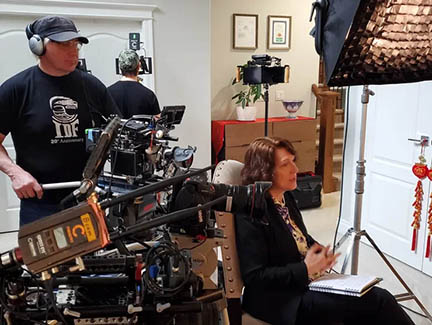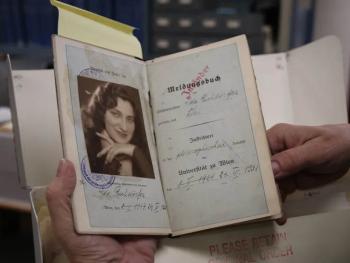Image Caption
Local Journalism Initiative Reporter
Windspeaker.com
Acimow Media has wrapped up filming Forbidden Music for Knowledge Network. The feature-length documentary explores Indigenous music rights and ownership, and how Chief Mungo Martin (Kwakwaka'wakw) worked to protect 123 traditional First Nations songs from disappearing through government assimilation tactics.
It is the fourth documentary by producer and director Barbara Todd Hager (Métis, Cree). Completing 16 days of filming in Austria, Canada and the United States, Windspeaker spoke to Hager as she entered post-production editing.
The documentary tells the story of Austrian-born Jewish ethnomusicologist Dr. Ida Halpern and artist and singer Chief Martin. They worked together to record songs threatened by the Potlatch Ban, as set out in the Indian Act from 1885 to 1951. It was also a time of the removal of Indigenous children to residential schools, where speaking their languages and learning their cultural practices were denied them.
Potlatch is a ceremony where nations come together and display their songs and dances. They commemorate such important milestones as coming of age, namings, marriages, deaths, and achievements. And they show gratitude to Creator. The host provides a feast to take care of his guests and shares his riches and gifts among them.
“I feel compelled to make documentaries that bring forward stories that would normally not get told,” Hager said.

Although the story touches on Dr. Halpern fleeing a genocide in Europe, Forbidden Music “is really a B.C. story,” said Hager. It's “set in Vancouver, Ya'Lis (Alert Bay), Tsaxis (Fort Rupert), the whole region around the Salish Sea.”
Spending days with “boxes and boxes” of Halpern’s letters and papers, Hager and her team explored the communications and dealings between the musicologist and Chief Martin.
Hager describes Halpern as an “interesting character” with a “contradictory” personality.
“The more I learn about her, the more I like her, and also question her motivations,” said Hager.
In 1938, Halpern was completing her PhD in musicology when “there was a lot of interest in Europe of ‘ethnic music’, as they would call it back then.” It was the time in history when the Nazis were taking over Austria and Jewish musicians and composers were banned.
Halpern comes to Canada, “and then she finds kind of a connection with Indigenous people who also had music that was banned.”
Ethnomusicology looks at both the technical side of music and the cultural side, Hager said.
“So that seemed to be her motivation, but it took about 10 years before she got her first interview with Chief Billy Assu," who was from Cape Mudge, now We Wai Kai, from around the Campbell River area on Vancouver Island. Halpern met Chief Martin through Assu, with the bulk of the recording done between 1950 and 1952.
Chief Martin’s life was greatly impacted by the ban on potlatches. He became a renowned carver in defiance of the ban. He was “concerned about the loss of language, music, art, everything that happened with the Potlatch Ban,” said Hagar.
Through interviews with family and community members, Hager explores how Chief Martin kept the songs alive.
“From what I understand, the potlatch still continued but underground.” Residential schools were taking children away and forbidding them to speak the language, including singing the songs, so the songs started to be endangered.”
“Mungo went to the cities of Victoria and Vancouver and started carving in public, often with universities or museums as his sponsors. So I think that showed that he wanted to make sure that people saw what the culture was and that it was still alive.”
He was at the University of British Columbia “doing some totem pole restorations” around the time he met Halpern. His wife Abayah and he would meet with her, and when she won his trust, she would record him singing, Hager said.
Ten years later or so, “I think it was about 1963,” said Hager, Martin wrote Halpern in beautiful handwriting:
“Dear Dr. Halpern, I understand you’re using the songs that we recorded and selling them for records and you didn’t pay me. Why are you doing that?” Hager surmises that personal benefit may have been Halpern's motivation all along.
So the questions arise around ownership.
Halpern copyrighted the songs that she recorded for record companies to distribute.
“That was a bit of a surprise for me to see that she basically owned the copyright to the recordings of all of the Indigenous singers she worked with,” Hager said.
“Somebody has to, essentially, own it to exploit it. Copyright is definitely not an Indigenous way of looking at the music. I don't think Chief Mungo Martin would've thought he owned the music, but that he had learned the music from his ancestors and Elders.”
While there are songs that are family owned in West Coast cultures, Hager says, “I doubt there was this thought that he owned them and he was selling them to her or somehow giving her the rights to them. For him, they were recorded to save songs from disappearing.”
Martin also recorded Haida and Nuu-chah-nulth songs. “But he made sure that it was clear that they were Haida (and Nuu-chah-nulth) songs.” He didn’t claim those songs to belong to his clan or family. “His motivation was to make sure they didn't die with him.”
Hager believes the other singers included in the recordings had the same concerns “What would happen to the music when they passed away?”
The songs were preserved, and young people today are learning the songs from the recordings. “They're being used to educate and train in the classroom,” Hager said.
“But what was the cost of that, and was Halpern’s involvement critical to the saving of those songs,” she wonders.
“Let's be honest, she exploited the singers in some ways,” said Hager. “She furthered her career. She would go to a lot of ethnomusicology conferences and give lectures and talk about her research. And there's cases where she would talk about ‘her’ Raven songs.”
“There’s an academic ownership of research that Western-trained anthropologists and archaeologists take because that's what they are told. They're allowed to do that. ‘You do the research, you own it.’”
It’s an area Hager has explored in other chapters of her life, including her work for six years with the Royal B.C. Museum ethnology department.
“I can definitely say that’s true.” Hager shared the experience of “working firsthand with university-trained researchers of Indigenous people. It’s almost like we’re specimens, or we are their projects.”
Hager says it brings her happiness to see “so many Indigenous people taking over roles in museums, becoming archaeologists and anthropologists.” Even though it’s a Western concept, said Hager, “it’s still taking ownership or control back.”
It was after working with the museum that Hager shifted her work to broadcast journalism. She began making TV documentaries for the Aboriginal Peoples Television Network, “and then I started this organization called The Alliance of Aboriginal Media Producers, and we started advocating for more awareness of what our needs were in the broadcast world.”
This work is as important as filmmaking itself, said Hager.
“Nowadays, if you're a non-Indigenous filmmaker or producer and you want to make an Indigenous film, you pretty much have to have a partner that's Indigenous now that owns 51 per cent of the production. And that's something that we—myself and other producers—fought for really strongly in the industry for years.”
When it comes to sharing art, songs and stories, “we've got to tell them, because it helps people understand why the stories or the music are so important.”
Local Journalism Initiative Reporters are supported by a financial contribution made by the Government of Canada.

